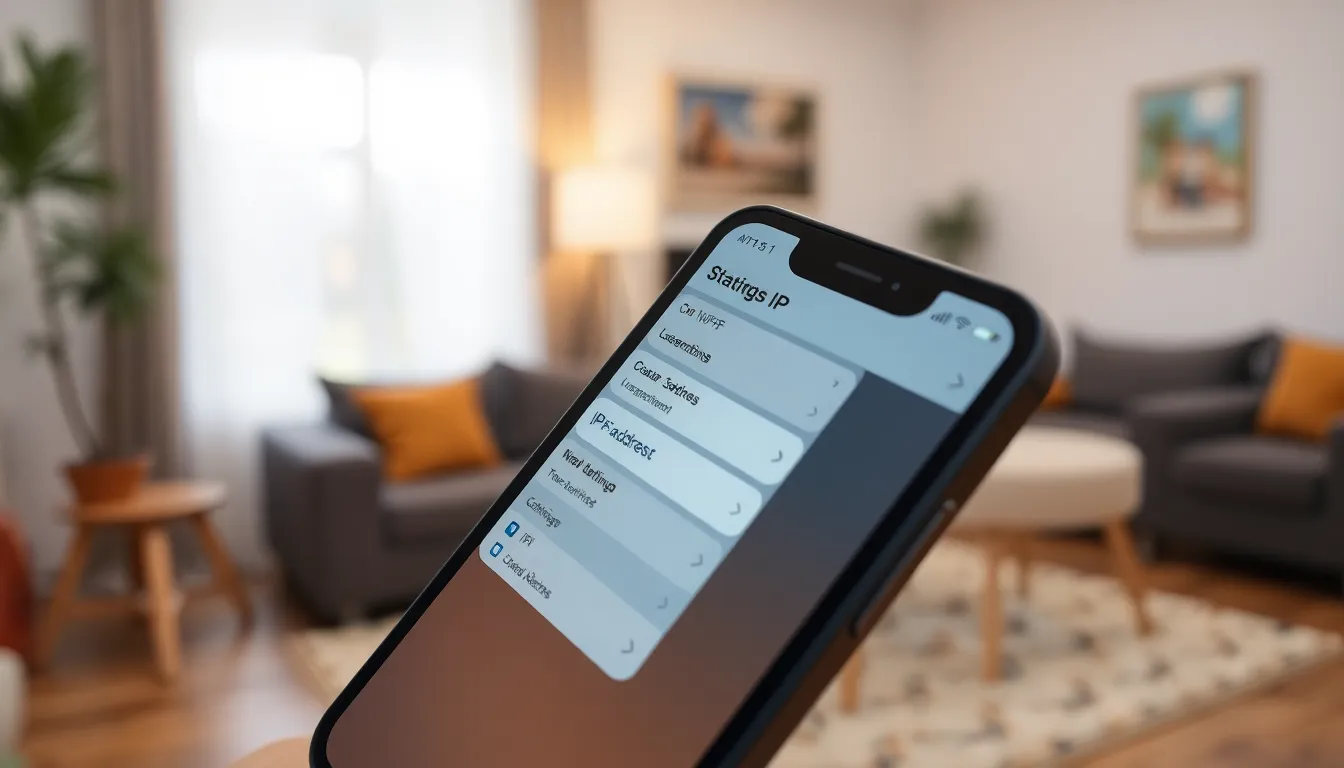Finding the IP address on an iPhone 13 might sound like a techy treasure hunt, but don’t worry, it’s easier than it seems! Whether you’re trying to troubleshoot a connection issue or just showing off your tech-savvy skills, knowing your device’s IP address can come in handy.
Table of Contents
ToggleOverview of IP Address
An IP address, or Internet Protocol address, serves as a unique identifier for devices on a network. It functions similarly to a home address, allowing data to reach the correct destination. Networks typically categorize IP addresses into two types: IPv4 and IPv6.
IPv4 addresses consist of four sets of numbers ranging from 0 to 255, separated by periods. For instance, 192.168.1.1 represents a common IPv4 address. Conversely, IPv6 addresses offer a more extensive number series, accommodating the increasing demand for IP addresses. They involve eight groups of alphanumeric characters separated by colons, such as 2001:0db8:85a3:0000:0000:8a2e:0370:7334.
Users can find their IP address locally or externally. The local IP address connects devices within a home network. External IP addresses provide the identification required for devices to interact over the internet.
Every time a device connects to a network, it receives an IP address from the router, which may remain constant or change with each connection—referred to as dynamic IP addresses. Static IP addresses, however, remain consistent and are often used for servers or services requiring a stable connection.
Understanding one’s IP address proves essential for troubleshooting network issues, configuring devices, or setting up security measures. Knowing whether an address is local or external aids in deciding what actions to take for effective network management.
Methods to Find IP Address on iPhone 13

Finding the IP address on an iPhone 13 can be done through various settings. Users often rely on two main methods: Wi-Fi settings and cellular settings.
Using Wi-Fi Settings
Accessing the IP address through Wi-Fi settings involves a few straightforward steps. First, the user opens the “Settings” app. Next, selecting “Wi-Fi” displays available networks. Tapping the connected network provides detailed information about the connection. The user’s IP address appears under the “IP Address” section. This address typically reflects the local network’s IP assigned by the router, using the IPv4 format for easy identification.
Using Cellular Settings
To find the IP address through cellular settings, the user follows a different route. Opening the “Settings” app leads to “Cellular.” Afterward, selecting “Cellular Data Options” shows various settings related to cellular connections. By tapping “Cellular Network,” the device displays the IP address related to cellular data. This information can differ from the Wi-Fi IP address, as it’s linked to the mobile network. Users find both IPv4 and IPv6 addresses listed for more comprehensive visibility.
Additional Information
Understanding IP addresses extends beyond simply locating them on an iPhone 13. The differences between public and private IP addresses play a significant role in network functionality and security.
Public vs Private IP Address
Public IP addresses identify devices on the internet, allowing them to communicate with external networks. Devices connected to the internet use these addresses to send and receive data. Private IP addresses, on the other hand, are assigned within local networks, facilitating communication between devices like phones, tablets, and computers. A router assigns private addresses to devices connected to it, shielding them from the public internet while still enabling communication within the network. Knowing when to use each type of address is key to understanding network operations and ensuring security.
Using Third-Party Apps
Third-party apps can simplify the process of finding an IP address. Numerous applications are available on the App Store that display network information, including both local and public IP addresses. Users can download apps such as “Fing” or “IP Scanner” for enhanced visibility and additional features. These apps often provide insights into connected devices, network quality, and potential security vulnerabilities. By utilizing a third-party app, individuals can gain more comprehensive data on their network and improve their overall management of network-related tasks.
Troubleshooting Common Issues
Users may encounter several common issues while trying to find the IP address on an iPhone 13. Connectivity problems often exist when the device doesn’t connect to Wi-Fi or cellular data. Restarting the iPhone can resolve many glitches, including network issues.
Another common problem arises when the selected network displays no IP address. Ensuring the Wi-Fi router is functioning correctly might help. Checking the network settings through the “Settings” app under “Wi-Fi” can also shed light on any misconfigurations.
Some users might not see the correct IP address listed under the specified network. This issue may involve a recent change in network settings or an update to the router. Accessing the router settings directly can provide additional insights.
Settings can become confusing when dealing with both IPv4 and IPv6 addresses. Identifying which version to use is crucial for proper connectivity. Not every application or service supports IPv6, which might lead to unexpected behavior.
Privacy concerns sometimes arise with public IP addresses. Users should ensure that sensitive information is secured, especially when sharing their public IP. Understanding the differences between public and private IP addresses becomes essential for informed decisions.
Lastly, third-party apps may not operate as expected. Some users report that apps like “Fing” or “IP Scanner” malfunction at times. Verifying the app’s permissions and ensuring the latest version is installed can mitigate these problems.
Proactive steps can greatly assist users in efficiently finding and managing their IP address on an iPhone 13.
Finding the IP address on an iPhone 13 is a straightforward process that can enhance users’ understanding of their network environment. Whether through Wi-Fi or cellular settings the steps are easy to follow and provide essential information for troubleshooting and network management.
By knowing the differences between local and external IP addresses users can make informed decisions regarding their connectivity. Utilizing third-party apps can further streamline this process offering valuable insights into network performance and security.
With a few simple steps users can gain better control over their devices and ensure a more secure and efficient online experience.




